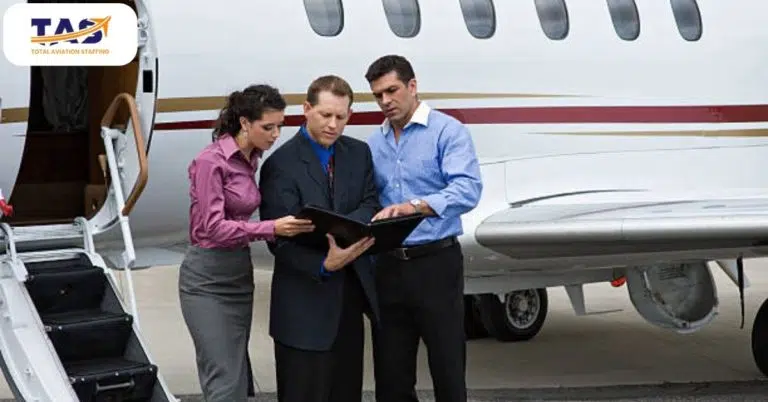Exploring the Duties and Responsibilities of an Aviation Director

Have you ever wondered what it takes to lead the high-flying world of aviation? Join us on a captivating journey as we delve into the duties and responsibilities of an Aviation Director.
From strategic decision-making to ensuring safety, efficiency, and team management, this blog will take you behind the scenes of this dynamic role. Fasten your seatbelt and get ready to explore the exhilarating skies where strategic leadership takes flight!
1. Strategic Leadership
In the role of Aviation Director, strategic leadership is a key responsibility that involves developing and executing the department’s goals and objectives in alignment with the overall organizational strategy. By providing vision and direction to the aviation team, the Aviation Director plays a crucial role in shaping the future of the department and driving its success.
Here are the roles they play in strategic leadership:
Develop and execute strategic goals and objectives for the aviation department.
Align the aviation department’s strategy with the overall organizational strategy.
Provide clear vision and direction to the aviation team, inspiring them to achieve excellence.
Identify opportunities for growth and improvement in the aviation department’s operations.
Foster a culture of innovation and continuous improvement within the team.
Collaborate with other departments and stakeholders to ensure strategic alignment and cross-functional success.
Monitor industry trends and advancements to proactively adapt the aviation strategy.
Evaluate and mitigate risks, ensuring compliance with regulations and industry standards.
Foster strong relationships with key stakeholders and partners to support the department’s strategic initiatives.
Continuously measure and evaluate the performance of the aviation department against strategic objectives.
So, as you embark on your journey as an Aviation Director, remember that strategic leadership is not just about setting the course but also about inspiring the team to reach new heights. By fostering a culture of innovation and collaboration, you’ll navigate the skies of success and steer your aviation team toward greatness. Get ready to spread your wings, embrace the challenges, and lead the way to a future filled with soaring achievements.

2. Budgeting and Financial Management
As the Aviation Director, budgeting and financial management are essential components of your role. You will be responsible for preparing and managing the department’s budget, overseeing operating expenses, capital expenditures, and implementing cost control measures. Effective financial management and resource allocation will be crucial to the success of the aviation department.
Here are the responsibilities they hold in the realm of budgeting and financial management:
Develop and implement the department’s budget, considering operational needs and strategic goals.
Monitor and manage operating expenses to ensure efficient use of resources.
Evaluate and prioritize capital expenditures to align with long-term objectives and investments.
Implement cost control measures to optimize the department’s financial performance.
Collaborate with finance and accounting teams to ensure accurate and timely financial reporting.
Conduct regular financial analysis and forecasting to identify areas for improvement and risk mitigation.
Provide strategic guidance on resource allocation, balancing budgetary constraints with operational needs.
Identify opportunities for cost savings and efficiency improvements within the aviation department.
Ensure compliance with financial policies, procedures, and regulatory requirements.
Communicate financial performance and budget updates to senior leadership and stakeholders.
By expertly navigating the financial landscape, controlling costs, and optimizing resources, you’ll lead the department to new heights of efficiency and fiscal strength. Get ready to balance the books, spread your financial acumen, and embark on a journey where financial stability and operational excellence go hand in hand.

3. Compliance and Safety
Compliance and safety are paramount to your role. You will be responsible for ensuring adherence to aviation regulations, safety standards, and best practices. Implementing and maintaining effective safety management systems will be crucial in fostering a culture of safety within the organization.
Here is an elaboration on your duties in compliance and safety:
Establish and enforce compliance with aviation regulations, both domestically and internationally.
Develop and implement safety policies, procedures, and protocols in line with industry best practices.
Conduct regular safety audits and inspections to identify and address potential risks and hazards.
Provide leadership in promoting a culture of safety throughout the organization.
Collaborate with regulatory authorities and industry stakeholders to stay updated on safety requirements.
Develop and deliver safety training programs to enhance awareness and competence among the aviation team.
Investigate and analyze incidents and accidents to identify root causes and implement preventive measures.
Continuously evaluate and improve safety management systems to mitigate risks and enhance safety performance.
Ensure effective communication and reporting of safety-related matters to relevant stakeholders.
Foster a proactive and transparent approach to safety, encouraging the reporting of near-misses and safety concerns.
Remember that compliance and safety are your co-pilots on the journey to success. By weaving together regulations, robust systems, and a culture of safety, you’ll safeguard the skies for employees and passengers alike, while soaring above the competition. Buckle up, embrace the safety protocols, and let your commitment to excellence shine through as you navigate the winds of compliance and safety.

4. Aircraft Operations
Overseeing aircraft operations is a critical aspect of your role. You will be responsible for managing various aspects, including flight planning, scheduling, dispatch, and maintenance coordination. Your strategic leadership will be instrumental in ensuring the efficient and effective use of aircraft resources while maintaining a strong focus on safety.
Here’s why your role is vital in Aircraft Operations:
Coordinate flight planning activities, considering factors such as weather, airspace restrictions, and fuel optimization.
Manage aircraft scheduling to maximize utilization and meet operational requirements.
Oversee dispatch operations to ensure timely and safe aircraft departures and arrivals.
Coordinate with maintenance teams to schedule and perform aircraft inspections and repairs.
Develop and enforce standard operating procedures (SOPs) to ensure consistent and safe aircraft operations.
Foster a culture of safety and compliance within the aircraft operations team.
Monitor and analyze key performance indicators (KPIs) to identify areas for improvement and drive operational excellence.
Collaborate with internal stakeholders to align aircraft operations with broader organizational goals.
Stay abreast of industry trends and technological advancements to enhance aircraft operations.
Whether it’s keeping flights on schedule or ensuring smooth landings, as an overseer of aircraft operations, you’ll be the ultimate captain of efficiency and safety. With your strategic prowess and a keen eye for detail, you’ll navigate the skies of success while leaving turbulence behind.

5. Team Management
Effective team management is crucial to the success of the aviation department. You will lead and manage a diverse team, including pilots, maintenance staff, and administrative personnel. Your strategic leadership will involve providing guidance, mentorship, performance feedback, and fostering a positive and collaborative work environment.
Here’s an elaboration on your role in team management:
Lead the aviation team by setting clear expectations, goals, and objectives.
Provide guidance and mentorship to team members, nurturing their professional growth and development.
Conduct regular performance evaluations and provide constructive feedback to enhance individual and team performance.
Foster a positive and inclusive work environment that promotes collaboration, open communication, and mutual respect.
Encourage teamwork and cross-functional collaboration among different roles within the aviation team.
Identify and address any challenges or conflicts within the team, promoting resolution and harmony.
Develop and implement training programs to enhance the skills and knowledge of team members.
Support a healthy work-life balance and employee well-being within the aviation team.
Lead by example, demonstrating integrity, professionalism, and ethical behavior.
So, as you take charge of your team’s flight towards success, remember that your leadership is the wind beneath their wings. By guiding, mentoring, and empowering your crew, you’ll create a harmonious work atmosphere where they can soar to new heights. Together, you’ll navigate the skies of achievement, leaving a trail of professional growth and fulfillment in your wake.

6. Risk Management
You will be responsible for assessing and mitigating risks associated with aviation operations. Developing and implementing risk management strategies and emergency response plans are essential components of your strategic leadership.
Here’s your pivotal role in risk management:
Identify and assess potential risks and hazards associated with aviation operations.
Develop comprehensive risk management strategies to mitigate identified risks.
Implement risk mitigation measures and monitor their effectiveness.
Establish and maintain emergency response plans to effectively handle unforeseen events and crises.
Collaborate with relevant stakeholders to ensure alignment and coordination in risk management efforts.
Conduct regular risk assessments and reviews to identify emerging risks and update strategies accordingly.
Provide training and education to the aviation team on risk management protocols and procedures.
Stay updated on industry regulations and best practices related to aviation risk management.
Foster a culture of risk awareness and proactive risk management within the aviation team.
Continuously monitor and evaluate risk management processes and make necessary improvements.
As the guardian of safety in the ever-changing skies, you’ll be the risk management maven who keeps operations soaring smoothly. With your strategic prowess and a keen eye for hazards, you’ll navigate through stormy uncertainties, leaving no turbulence uncharted. Together, let’s keep the skies clear and the wings of progress unfurled, because when it comes to risk, you’re the pilot that never loses control.

7. Reporting and Communication
The role entails the responsibility of preparing regular reports and presentations that cover various aspects of aviation operations, performance metrics, and key initiatives. Furthermore, it involves fostering clear and efficient communication with senior management, stakeholders, and other departments within the organization.
Your responsibilities in terms of reporting and communication include:
Prepare comprehensive reports and presentations on aviation operations, including key performance metrics and achievements.
Present findings, insights, and recommendations to senior management and stakeholders.
Communicate effectively with other departments to ensure alignment and collaboration on cross-functional initiatives.
Provide updates on the status of key projects and initiatives to relevant stakeholders.
Synthesize complex information into clear and concise reports and presentations.
Tailor communication styles and formats to different audiences and their specific needs.
Foster open and transparent communication channels to encourage collaboration and information sharing.
Seek feedback from stakeholders to continuously improve reporting and communication processes.
Stay updated on industry trends and best practices in reporting and communication.
Use data visualization and storytelling techniques to convey information effectively.
With you at the helm, informed decisions and collaborative success take flight. Your strategic reporting and communication skills are the jet fuel that propels us forward. Buckle up for a soaring journey of excellence!

Wrapping Up
As we conclude this exhilarating exploration of the duties and responsibilities of an Aviation Director, it’s clear that this role is truly a flight of strategic mastery. From soaring through budgeting and compliance to steering teams and managing risks, these directors keep operations on a steady course. So, whether you dream of taking to the skies or are simply intrigued by the behind-the-scenes magic, remember that in the world of aviation leadership, there are always clear skies ahead for those who dare to reach new heights.
Ready to take your aviation career to new heights? Explore exciting job opportunities in the aviation industry with Total Aviation Staffing! From A&P mechanics to flight attendants and customer service roles, we connect you with top aerospace and aviation companies across the U.S. Let us help you find the perfect role, enhance your resume, and guide you toward your dream job. Take control of your future and soar towards success. Visit our website and start your journey today!
